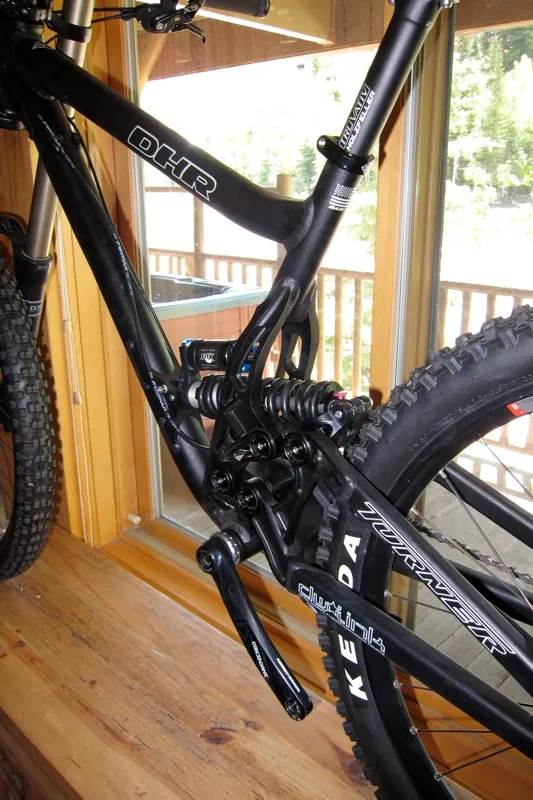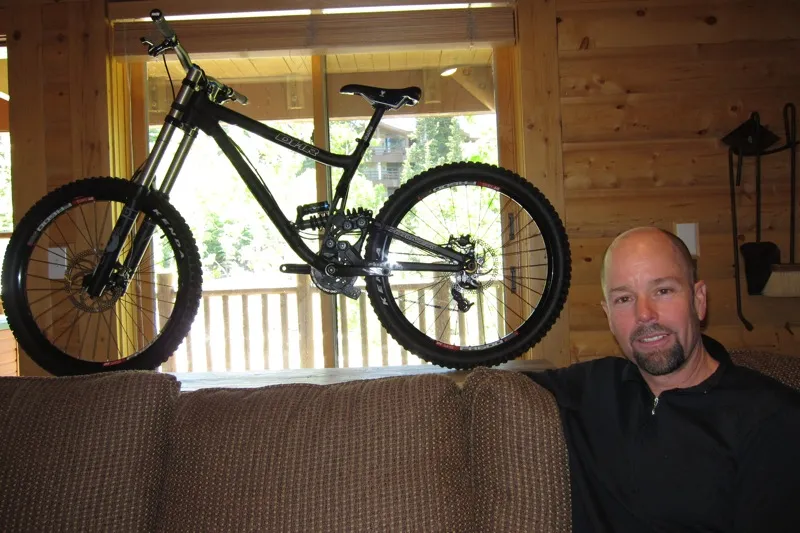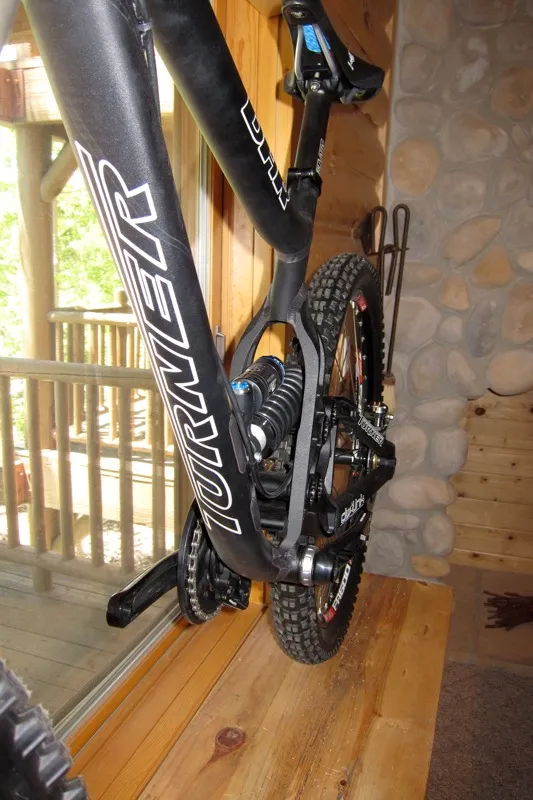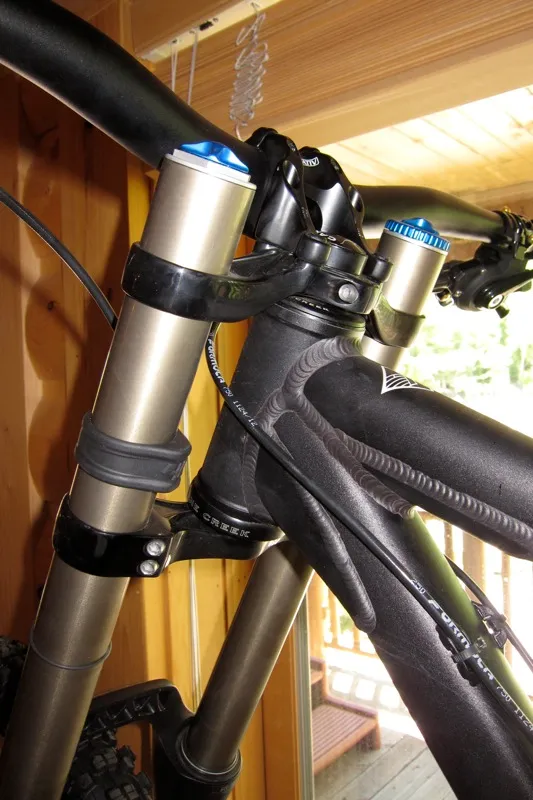David Turner has been building bikes since mountain biking’s mid-1990s heyday. Three years ago he teamed up with Dave Weagle, licensing his DW-Link suspension system. And finally this past season Turner unveiled the long awaited DW-Link remodel of his iconic DHR downhill bike. BikeRadar caught up with him to talk about his bike, shock and suspension design philosophies.
BikeRadar: What brought you and Dave Weagle together?
David Turner: It started in Phoenix, Arizona at South Mountain [in winter 2007]. We were co-attending a Manitou new product industry junket and when they set us up on our trail ride to evaluate the suspension, Dave and I ended up with the same engineer and sales ‘handler’, if you will. We were pedaling along and I started a conversation with Dave about how it [the DW design] functions, you know, the big question – how’s it different from VPP?
He started to explain it on the trail and, as Dave will, he said, ‘the best way to understand it is to ride it.’ So we switched [bikes] and it was pretty apparent in the first 150 yards. I felt that the [DW-Link] bike wasn’t squatting as much as the bike I [brought], yet I could feel it when I hit embedded rock – its suspension really would function, especially under power.
How did you come to license that design for your bikes?
Something that Turner bikes have always had as part of the design is that it’s an active bike that bobs as little as possible. There used to be this Turner slogan: 'full time function'. That means active while pedaling and, of course, active braking. Now, fast forward to my first experience with DW – I realized that Dave had it down, better than I did.
I did some pretty neat bikes. My Horst-Links, I think, are still some of the best pedaling; if you take a 2005 5.Spot and compare it with other 5.5in bikes, it’s still a pretty awesome bike in terms of resisting pedaling induced bob and being an active bike. But what we’re producing today with Dave Weagle’s help and his linkage, it’s a whole other level.
His calculations and his skills with physics and math to figure out where the center mass is and how much force is applied to the cranks and driving, the squat and anti-squat, it’s like a surgeon; he’s like a surgeon with the mathematics of the bike. So we started working together in 2007 for a ramp-up of a 2009 model launch, which would have been fall of ’08.
How do you guys interact when designing a bike?
The way that the design process works is that I create this matrix of the bicycle – every angle, every tube length [for each size frame], every single dimension and piece of geometry, including tire size (because tires affect bottom bracket height and bottom bracket height affects anti-squat), wheel travel and, of course, what shock I expect it to have (length and stroke, and the location on the bike).
I provide all of this to him and he plugs it into his software, which he's created for engineering the kinematics of a bike. I can guarantee you that there are many people doing engineering or pseudo engineering out there that are worried first about where the front derailleur is and everything else [logistically working out]; Dave’s primary focus is the anti-squat curve.
Then he and I work together to tune the structure to accept common bicycle parts. We’re really after the best bike under pedaling, and Dave and I are on the same page philosophically, with the idea that the bike has to remain active in rocks. Otherwise, why have suspension?
Most mountain bikers spend two-thirds of their time going uphill and if you live in rough terrain [and the suspension isn’t working when you’re climbing then you’re inefficient]. He rode my bikes before they were DW bikes and he knows my geometry. He leaves me to the geometry end.
How is that anti-squat curve tailored? Does it meet your vision of how the bike should work or is his anti-squat curve simply applied to your bike geometry and design?
I think it’s both. I know that maybe it doesn’t sound like you can have both, but the truth is that he's given a great deal of energy to each of his licensees with optimum anti-squat in mind. Then when you start messing with the individual geometries that we each choose, the net result ends up feeling different. That’s proven in the marketplace – that there's a different feel among the different [DW-Link] bikes. As far as the anti-squat calculations, they're all very similar but they don’t feel the same in the field.
Has there been revision to the anti-squat curve that you’ve used over the past three years?
No, not on the Flux, 5.Spot and Sultan. We did get the [Fox RP23] Boost Valve shock after two years of testing and that affects how the bike feels in regards to small bump compliance, but the anti-squat hasn’t changed. In fact, if someone wants a 2012 142x12mm rear end on a 2009 model they can certainly buy it and we'll make it as cost effective as possible.

2011 Sultan 29er with a Fox RP23 Boost Valve equipped shock
Why did it take so long for Turner to adopt Fox’s Boost Valve shock design?
The way I understand the Boost Valve to work in the RP23 shock is that it increases resistance to compression to a certain [shaft] speed. That works really well in some cases, but like anything else it has to be dialed and tuned to work with a suspension system. With our bike, with the DW-Link, at the ratios that we were running [gross shock, 2.6:1], we just felt that the ‘boost’ was too much.
When the boost opens, then it flows a nice amount of oil, but until it opened we felt that the small bump compliance wasn’t as good as the Bellville (Float design), which has less resistance to overcome. The reality is that it was too boost-y for the small bumps on our bikes, so we kept bugging them to help us out and finally they did it for us. And now, when it’s in the rocks, it’s pretty cool, because now it opens up and moves more freely.
In light of the current trend toward slacker geometry, do you see Turner filling that trail-plus category of a light, pedaling friendly 6-7in travel trail bike?
It’s on the schedule, we want one, but it’s just a matter of getting through the other bikes that are in front of it. We have holes in our line, which are a cross-country race bike and a bike in between the DHR and 5.Spot. The RFX, the most over-talked-about, beyond … it was a mistake on my part to be as transparent as I was with that.
I had a meeting with another small bike company owner a couple months ago and he shared his thoughts on that. He said, ‘don’t tell anybody what you’re doing until you’re really ready to do it.' That was good advice.
I asked him why he was giving me this advice and he said, ‘well, several years ago you spent a lot of time speaking with us about the trials and tribulations of patents on suspension and what you’d learned and all of this other stuff, so I thought I’d return the favor.'
Can you offer insight on center stiffness, tube profiles and bike design? Looking at the DHR the word svelte comes to mind, whereas other downhill bikes might be better described as stout...
[The DHR] isn’t crazy light, but it's one of the lighter [downhill] bikes on the market and it rides extremely light, because of its weight placement. When you look at it, the seatstays are pretty svelte and the top tube is as well, but the further you get from the center you get that light feeling, being able to move it around.
But as I understand it, you’ve done a lot of engineering to keep the two wheels in plane?
Yes. The down tube is a pretty good size and the seat tube is really short, and even the [smaller] top tube is driving energy into the ‘cage’ as we call it [the DHR’s center pivot/shock housing]. You get a lot of the bike’s stiffness from the cage because the rider’s weight is standing on the cranks.

The DHR's 'cage'
You watch the [good] guys on a downhill bike and they go into the turns and they actually counter-throw the bike forward in an S motion and then they smack it into the turn. Well, so much of the energy at that point is from the rider’s feet to the rear wheel – they’re basically drifting it – and their feet is where all the weight is.
So, if you can keep that stiff, [the bike will feel stiff]. At that point the handlebar is just adjusting the counter-steer so that the bike comes out at the right trajectory. You watch these modern guys and their hands are pretty light, so to me, much of the control comes from the feet back. Obviously the bars are used, but as they’ve gotten so wide you just have to put a little bit in.
The cage is key. We’ve had a cage of some sort for a long time; we used to call it the ‘big block,’ because it started off as a big-ass hunk of aluminum back in 2000. It also carried the link; at the time the link swung. That bike is still being copied today; that first DHR with the high link swinging the shock forward into the down tube.



